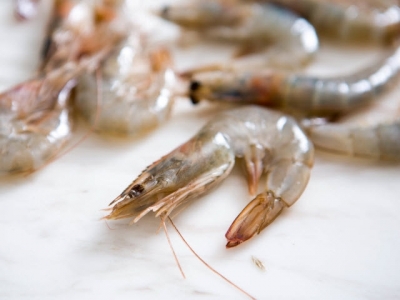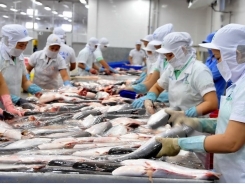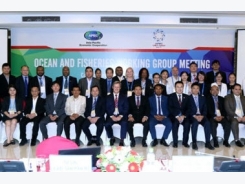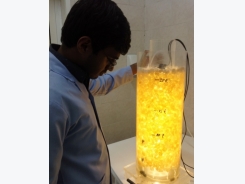Strong growth seen in global shrimp market

Global shrimp producers had a good year in 2016, according to a report by Globefish – especially on the export market.
The total was happy news for producers, as early forecasts predicted lower totals as disease and adverse weather conditions took their toll in the first half of 2016. However, the situation recovered during the second half of the year.
Asian countries led the way in national comparisons of production of shrimp. In total, the continent’s producers farmed an estimated 2.5 million metric tons of shrimp, the majority of which was P. vannamei, the whiteleg shrimp.
India came top of the league table, exporting 438,500 metric tons (MT) of shrimp, up 14.5 percent over 2015. Vietnam was second with exports of 425,000 MT, up 18 percent. Ecuador – the sole non-Asian country in the world’s top six exporters – shipped 372,600 MT of shrimp, up 7.8 percent. In fourth place, Indonesia exported 220,000 MT, up 21 percent; Thailand was fifth with 209,400 MT of shrimp production, up 22 percent, and China was sixth, exporting 205,300 MT, up seven percent.
Total production in China was estimated to be between 600,000 and 800,000 MT in 2016, with southern provinces reporting a sharp decline in output of more than 150,000 MT. India and Vietnam produced around 400,000 MT each, with Indonesia just behind at 350,000 MT and Thailand at 300,000 MT. Vietnam also produced 250,000 MT of black tiger shrimp in the Mekong Delta.
Latin American countries produced between 500,000 and 600,000 MT of P. vannamei during the year, with Ecuador and Mexico leading the supply. Nicaragua, Peru, Venezuela, and Honduras also ranking as top producers.
Landings of wild-caught shrimp were up in Argentina, increasing by 17 percent to reach 167,300 MT in 2016. This increase led to a 32 percent rise in Argentinean shrimp exports.
It was a different story in the U.S.A., where 2016 landings of shrimp were the lowest since 2010.
On the imports front, 2016 saw moderate increases in the USA (up 3.2 percent to 606,000 MT), Japan (up 4.6 percent to 223,600 MT) and China (up around 4.5 percent at 350,000 to 360,000 MT). However, China’s official reported imports figure is not entirely reliable, as rumors persist that a large proportion of China’s imports were smuggled across the Vietnam-China border. Argentina, Canada, Ecuador, Thailand, and Greenland supplied the bulk of the legal shrimp imports into China.
Import/export figures can also be misleading due to a growing trade in raw product imported for reprocessing and re-export. For example, Vietnam imported more than 300,000 MT of frozen shrimp for this purpose in 2016.
The European Union imported 780,000 MT of shrimp, two percent more than it did in 2015. In the EU-28, the main importers of frozen shrimp were France (77,000 MT) and Spain (66,000 MT). The Netherlands, Italy, the United Kingdom, Germany, and Belgium all imported between 25,000 MT and 30,000 MT.
France, Spain, and Italy imported the majority of their shrimp from South American countries, whereas the Netherlands and Germany favored imports from Southeast Asia. Varying amounts of intra-EU trade also took place, with Germany taking the highest volumes, particularly from the Netherlands and the U.K.
One supply change in the E.U. in 2016 was a fall in imports from India, following a move by the E.U. veterinary authority to increase the number of mandatory checks on Indian farmed shrimp from 10 to 50 percent. This consequently increased the cost to importers, many of whom sought product from elsewhere.
Value-added shrimp products are starting to play an increasingly important part in global trade. For example, just under 27 percent of imports into Japan in 2016 were made up of value-added products such as tempura shrimp, cooked shrimp, and sushi shrimp with rice.
However, in the U.S.A., demand increased for raw shell-on, raw peeled and cooked shrimp, but declined for breaded shrimp. Imports of large and medium-large shell-on shrimp (U/15 to 21/25) increased by nine percent in 2016 to reach 90,000 MT, but imports of medium sizes (31/40 to 51/60) remained at a similar level to the previous year at 87,000 MT.
On the food safety front, the U.S. Food and Drug Administration (FDA) rejected 133 consignments of shrimp in 2016 as a result of finding prohibited antibiotics. This was the third-highest number of refusals since 2002. The origin of the shipments was India (95), Vietnam (17), and China (15).
A comprehensive report, “Cooked shrimp in France” by EUMOFA, the European market observatory for fisheries and aquaculture products, also took a wider look at the E.U. market for this product. It found that shrimp is generally imported as a raw, frozen product, which is cooked and packed in the importing country.
In France, more than two-thirds is sold as a cooked, chilled product, and an examination of the retail market for P. vannamei found that a surprising 80 percent is sold on special offer.
Most tropical shrimp are still marketed whole in France, but demand for easy-to-cook and convenience food products is growing, resulting in a rise in sales of headed and peeled cooked and chilled shrimp, and marinated shrimp products.
Another aspect of shrimp supply that is growing is the need for certification, according to EUMOFA. Negative media stories continue to circulate about shrimp farming, particularly in Asia, with criticism leveled at aquaculture producers for their negative impact on the environment and use of poor labor practices.
Buyers for the large supermarket chains in northern and western Europe now require farms to prove that their products are sustainably and responsibly farmed. Preferred forms of proof include meeting the standards of GlobalG.A.P., the Aquaculture Stewardship Council (ASC), or Global Aquaculture Alliance’s (GAA) Best Aquaculture Practices (BAP) certifications programs.
The number of shrimp producers signing up to certification schemes is growing fast, and while achieving standards of the three most popular certification programs is not an easy nor a cheap process, it serves the dual purpose of providing market access and giving reassurance to consumers, according to the EUMOFA report.
Có thể bạn quan tâm
Phần mềm

Phối trộn thức ăn chăn nuôi

Pha dung dịch thủy canh

Định mức cho tôm ăn

Phối trộn phân bón NPK

Xác định tỷ lệ tôm sống

Chuyển đổi đơn vị phân bón

Xác định công suất sục khí

Chuyển đổi đơn vị tôm

Tính diện tích nhà kính

Tính thể tích ao hồ



 Despite of barriers, pangasius fish exports to the…
Despite of barriers, pangasius fish exports to the…  Novel reactor developed for indoor, high-density production of…
Novel reactor developed for indoor, high-density production of…